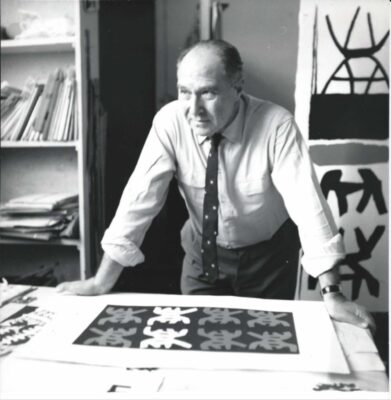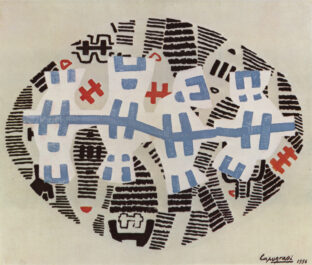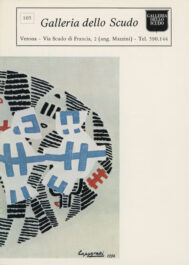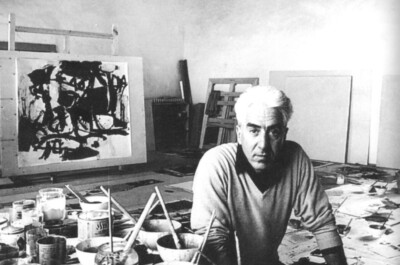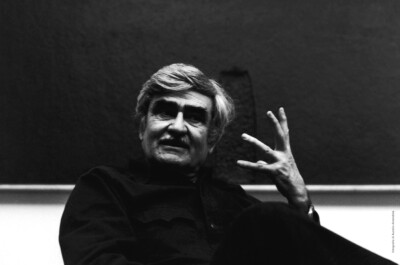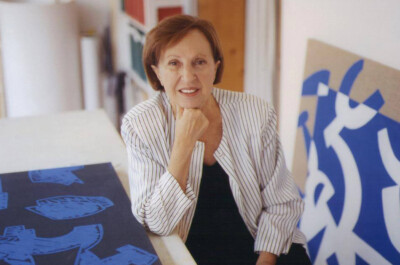Giuseppe Capogrossi was born in Rome in 1900. His father, Guglielmo, belongs to an ancient and noble Roman family, that of the Counts Capogrossi Guarna. His mother, Beatrice Tacchi Venturi, comes from a family originally from San Severino Marche. Graduated in Law, in 1923-24 he studied painting with Felice Carena and in 1927 he went to Paris with Fausto Pirandello. It is the first trip to the French, followed by many more in the following years. Present in 1930 at the XVII Venice Biennale, he began to take part regularly in the “Sindacali” exhibitions, the Venice Biennale and the Triennale, Milan.
At the beginning of 1933 in Milan Capogrossi exhibited in the "Group of new Roman painters" at the Galleria del Milione, epicenter of Italian Abstractionism. In October they decided to draw up the Manifesto del Primordialismo Plastico. In December in Paris Capogrossi took part in the Galerie Jacques Bonjean at the Exposition des Peintres Romains with Cavalli, Cagli and Sciavi, presented by Waldemar George as "Ecole de Rome". In 1937 he was featured in three international exhibitions: The 1937 International Exhibition of Paintings in Pittsburgh (the painting Ballo sul fiume won the second prize), Anthology of Contemporary Italian Painting at the Cometa Art Gallery in New York and a review of Italian art at the Akademie der Kunste in Berlin. In 1939 he had a personal room at the III Quadriennale in Rome.
In 1942 Giuseppe Capogrossi won an award at the IV Premio Bergamo with the painting Ballerina. In these years in his painting, also reflecting on Cézanne, he begins a transformation where the color lights up in the ranges of reds, purple and orange, while the brushstroke comes alive. In 1946 he inaugurated his first oneman show at the Galleria San Marco. Since 1947 he has been staying repeatedly in Austria, near Lienz, where he draws piles of wood, suggesting increasingly geometrized forms. In 1948 at the XXIV Venice Biennale he presented Le due chitarre (1948), now in the collection of the Galleria Nazionale d’Arte Moderna e Contemporanea in Rome, the result of the new neocubist phase.
In 1950 in Rome, to the consternation of the critics, he presented his new abstract works at the Galleria del Secolo. The catalogue presentation was by Cagli who spoke of a reduction to black and white of a vast range of tones a denunciation of the gravity of the times, and the use of a constant element determined by a group of marks aimed at expressing the archetypes of group consciousness. In 1951, together with Ballocco, Alberto Burri, and Colla, he founded the Gruppo Origine while, in the following year, he became part of the Spatial Movement in Milan. In 1954 Michel Seuphor published the first monograph about his painting, which made no mention of his figurative phase. In 1955 he took part in “Documenta I” in Kassel, at the III São Paulo Biennale in Brazil, while Giulio Carlo Argan wrote the catalogue presentation for his solo show at the Galleria del Cavallino. Having by now become internationally famous, the artist held solo shows in Paris (at the Rive Gauche, 1956), and then London (1957), New York (Leo Castelli, 1958), and Brussels (1959).
In 1962 at the XXXI Venice Biennale, he was given a room to himself and came joint first for the Biennale’s prize together with Ennio Morlotti. In 1964 he exhibited at the Renato Cardazzo’s Galleria del Cavallino in Venice, invited by Renato Cardazzo, dealer who owned also the Galleria del Naviglio in Milan, where Capogrossi often exhibited. In 1967 Giulio Carlo Argan and Maurizio Fagiolo published the third monograph about his abstract work. In 1971 he was awarded the “Vent’anni di Biennale” prize, while the ministry for public education awarded him its gold medal for cultural merit. Giuseppe Capogrossi died the following year in Rome. Only in 1974, after the artist had destroyed or reused various figurative canvases, did the Galleria Nazionale d’Arte Moderna organise an anthological exhibition of his whole output.
